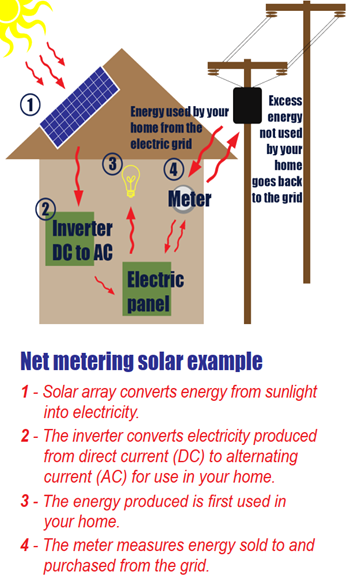Net Metering Explained
Generating Your Own PowerThere is growing interest in small-scale, home or business-based |
 |
|
|
Tell me simply. What is net metering?Net metering, as the name implies, is a metering process designed Give me an example.Suppose you have installed DG at your Missouri home or business |
What is avoided cost?
Per the Missouri Net Metering Act, any credit from generating more energy than you use will be based on the average monthly avoided cost of Associated Electric Cooperative, Inc. (AECI), your cooperative’s wholesale power provider. Avoided cost is what it would cost AECI to generate power or purchase power from another utility. The credits will never be paid in cash to a member. They may only be used as a credit against energy used and billed at the cooperative’s retail rate (see example on right). Under the Act, the credits must be used within 12 months or they expire without compensation.
You will still have an electric bill.
Regardless of the amount generated by your DG system, you will always need to pay your cooperative’s fixed monthly rate, also referred to as a basic charge or availability charge. This charge helps your cooperative offset operating costs for things such as poles, wires, meters, and other infrastructure to keep your power safe and reliable. Your net metering credits are not applied against that charge.
How do the meters work?
Every electric cooperative member has an electric meter that records the amount of power delivered by their cooperative. As electricity is used, the meter spins forward, much like a car’s odometer records miles traveled. Under net metering, your cooperative can use either a single bi-directional meter or two meters to measure the net of the energy used and produced. A single bi-directional meter will provide your cooperative with two readings - one for the energy purchased from the grid and one for the energy provided to the grid. Your cooperative will then “net” these two readings to determine the monthly bill. Alternatively, your cooperative may use two separate meters to acquire these two readings.
What are my next steps?
If you are considering installing a DG system, talk with your local electric cooperative first. Not only will this be helpful, you are also required by law to inform and work with them prior to installing a DG system that connects to the grid to be sure it meets safety requirements. You cooperative can provide resources to help you decide if a DG system is right for you, and provide you with the proper information and forms you will need going forward.

